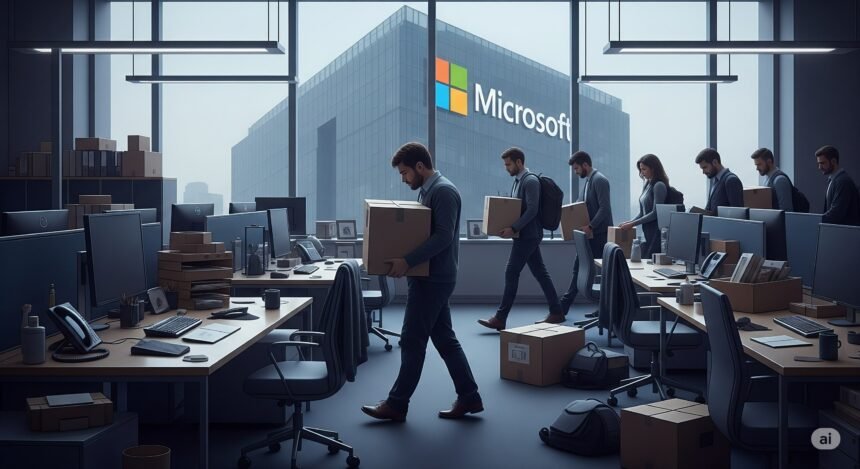Redmond, Washington – Microsoft has announced the layoff of approximately 830 employees based in Washington state. This move is part of a sweeping global reduction affecting around 9,000 roles, marking the company’s most significant wave of job cuts in over two years.
On July 2–3, 2025, Microsoft submitted a formal notice to the Washington State Employment Security Department, confirming that 830 jobs across various divisions will be eliminated. This figure represents less than 10% of the total headcount impacted in the latest round of cuts, which equates to roughly 4% of Microsoft’s global workforce of approximately 228,000 employees as of June 2024.
Employees at risk include personnel from gaming Xbox, legal, hardware engineering, Microsoft Research, and cloud solution architecture. Among those affected are nearly a dozen game designers, three audio designers, two mechanical engineers, an optical engineer, a lab technician, five research contributors, and a manager. Additionally, legal teams saw ten lawyers laid off, while hardware engineering also lost six roles.
Microsoft Explains the Reduction
Microsoft framed the layoffs as part of a strategic effort to “streamline operations for a dynamic marketplace,” emphasizing the removal of specific management layers to enhance agility. CFO Amy Hood has underlined this focus on learner teams and stronger efficiency during quarterly earnings calls.
According to analysts, this restructuring enables Microsoft to reallocate resources toward high-growth areas, such as artificial intelligence (AI) and cloud computing, while trimming slower-moving segments, including Xbox and certain engineering functions.
The Bigger Picture: AI-Driven Realignment
This wave of layoffs follows previous reductions, with nearly 6,000 roles cut in May and another 300 in June, primarily in the Puget Sound region. Together, these changes signal a broader shift: Microsoft is embedding AI deeply across its operations, including the integration of AI tools into coding and automation processes. CEO Satya Nadella has estimated that AI may write up to 30% of code used in certain areas.
Analysts at Wedbush Securities suggest Microsoft is “overhauling legacy divisions like Xbox” to enable investments in next‑generation AI and cloud infrastructure. The push reflects efforts to strike a balance between aggressive investment in AI. Microsoft spent an estimated US $80 billion on data centres, specialized chips, and AI systems last fiscal year with prudent cost controls.
Impact on Washington State Tech Ecosystem
The region is one of Microsoft’s largest employment hubs, with approximately 54,000 local staff before the cuts. These new reductions bring total layoffs in the state to more than 3,100 in just two months, a sharp economic blow to Puget Sound’s tech sector.
Industry observers warn that the departures of specialized roles, such as those in mixed reality, hardware, and research, will spur a migration of talent. Some may find opportunities in startups or rivals focusing on AR/VR and emerging technologies.
Voices from Employees and Analysts
Several laid-off Microsoft employees posted on LinkedIn and other social media platforms, describing their experiences and searching for new roles. One document filed with Washington state officials detailed the variety of job functions affected, including cloud architects, game designers, lawyers, mechanical and optical engineers, and a range of research positions.
Phil Spencer, head of Xbox, sent a memo to the gaming division, explaining the layoffs as necessary to “position the video game business for enduring success” and to align with Microsoft’s broader push to trim management and raise effectiveness.
Wedbush analyst Dan Ives added, “They’re focused more and more on AI, cloud and next‑generation Microsoft and looking to cut costs around Xbox and some of the more legacy areas. I think they over‑hired over the years. That’s the name of the game on Wall Street.
What’s Next From Microsoft?
Microsoft has characterised the layoffs as just one aspect of its ongoing organisational transformation. The company recently formed an AI “hub” in London and continues expanding its cloud infrastructure while navigating regulatory scrutiny, including a 2024 FTC investigation into its market behaviour.
Looking ahead, Microsoft is expected to reinvest the savings from these cuts into AI and cloud services, particularly through partnerships with OpenAI, Azure expansion, and the development of enterprise AI tools. Yet the layoffs underscore the changing nature of tech work: as automation and generative AI tools mature, companies are balancing workforce reduction with new kinds of investments.
For the broader tech ecosystem in Washington state, the next few months will test the region’s ability to reabsorb specialized talent or support entrepreneurial efforts that draw on this pool of experienced professionals.
This is a pivotal moment in Microsoft’s evolution, one in which the company reshapes itself around AI-driven priorities while making tough decisions on legacy segments. As systems and teams realign, the move will resonate not just within Redmond but across the broader tech landscape.






